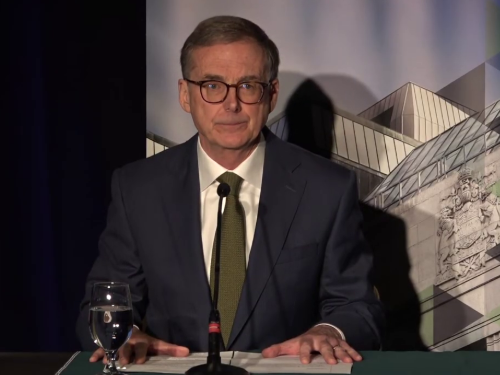Introduction
It’s a pleasure to be here in Newfoundland and Labrador. I want to thank the St. John’s Board of Trade for the invitation to speak to you today. There is no better place to talk about trade than a community of exporters. The sea routes that begin and end in St. John’s have helped feed, supply and build Canada and the world.
Port cities are attuned to global commerce. And until recently, the global economy had been recovering well from the hard years of the pandemic. Canada, a country that depends on foreign trade, was benefiting. At the end of 2024, inflation in Canada had been close to the 2% target for months. Substantial interest rate reductions had boosted household and business spending, and exports were strengthening. The economy had renewed momentum.
But then something happened. Since President Trump took office in January, the world has faced a dramatic escalation in tariffs and pervasive uncertainty. In Canada, trade has been disrupted and jobs have been lost. Businesses have re-evaluated their investment plans. Consumers have become more cautious. And Canadians have told us that they expect higher prices for many imported goods.
The recent announcement that Canada and the United States agreed to negotiate a new economic and security relationship within 30 days is very welcome news. Restoring open trade between our countries is critical to jobs and growth in Canada. It is also important for prices and inflation.
Today I want to talk about the effect US trade policy has already had on the Canadian economy and what tariffs could mean for jobs and inflation if they were not rolled back.
I’ll start with trade. New US tariffs have already shaken Canadian exporters. After an initial pull forward to get ahead of tariffs, exports to the United States have fallen sharply. Canadian businesses are doing their best to pivot to new overseas markets, but it’s hard to replace our biggest export partner right next door.
Then I’ll turn to jobs. There have been layoffs in industries affected by tariffs, and employment has fallen in trade-sensitive sectors. What happens to the labour market next will depend critically on what happens with the Canada-US trade relationship. It will also depend on how much we can expand trade within our country and overseas.
Finally, I will explain the implications of tariffs for inflation. Higher tariffs that weaken growth and cut jobs put downward pressure on inflation. But higher tariffs also add costs, which increase consumer prices.
The best way to avoid the job losses and price increases caused by tariffs is to not have tariffs.
The impact of US trade policy on our exports and how it spreads through the economy matter a lot to families, businesses and communities. Heightened geopolitical tensions are also weighing on Canadians. We are living in a more shock-prone world.
At the Bank of Canada, we are proceeding carefully with monetary policy. We want to see through the noise to set policy that supports the economy while ensuring inflation remains low and stable for Canadians.
The trade conflict has disrupted Canadian exports
To understand how the trade conflict has affected Canadian trade, we have to look at where we were heading before tariffs.
Canadian exports were growing in 2024 as the global economic recovery gained momentum, and the Bank expected them to continue to strengthen.1 In our January Monetary Policy Report—the last one before the trade war—we forecast goods exports would grow roughly 2½% in 2025 and 3½% in 2026, outpacing overall growth in gross domestic product (GDP).
That all changed with the inauguration of President Trump. Since February, the United States has imposed, suspended, re-imposed and partially rolled back tariffs on many countries. For Canada, the most important tariffs that remain in place are on motor vehicles, steel and aluminum, and these have had a big impact on Canadian exports.
The changes in US trade policy have caused shifts in Canadian trade across two dimensions. They’ve changed the timing of exports and imports. And they are changing the destination of shipments.
First, timing. To get ahead of tariffs, businesses that export to the United States immediately shipped as much as possible. Canada’s goods exports rose 10% in the first quarter of 2025 from the fourth quarter of 2024 (Chart 1). Exports of machinery and equipment and motor vehicles led the surge, but lumber, as well as consumer goods like food and pharmaceuticals, also rose sharply.
First-quarter imports were also up as Canadian importers stockpiled US goods, building inventories before costs rose.
The surge in trade and inventories boosted the economy—Canadian GDP growth was 2.2% in the first quarter.
But getting ahead of tariffs borrowed activity from the future, and we’re now seeing a sharp reversal. Canadian goods exports to the United States dropped more than 15% in April. This reflects both the payback from the first-quarter surge and the fact that tariffs are making Canadian goods more expensive in the United States. In April, exports of steel and aluminum products fell 11% and 25%, respectively, and motor vehicle exports were down almost 25%.
There has also been a second, less-dramatic shift caused by US trade policy—destination. As Canadian exporters have tried to adapt to US tariffs, trade with countries other than the United States has picked up (Chart 2).
Canadian businesses—who showed remarkable agility to digitalize during the pandemic—are seeking out new suppliers and new export partners to replace US trade.
There are clear and enduring benefits of trade diversification
Growing new markets for our exports builds scale and competitiveness. But there’s an added imperative—diversification adds resilience. Without diversity of supply, Canadian companies are vulnerable to supply problems, as we saw during the pandemic. Without diversity of demand, they’re vulnerable to trade barriers, as we’re seeing now.
Here I want to mention the success your province has had in diversifying trade. About three-quarters of Canada’s goods exports go to the United States. But only about one-third of Newfoundland and Labrador’s goods exports are US-bound—mostly oil and gas, fish and seafood, and nickel. The dependence on US markets has declined as local energy producers shift to other markets. More than half of the province’s oil is now shipped by tanker to Europe and other countries, up from less than 10% 20 years ago. That’s the Newfoundland and Labrador advantage—access to tidewater, a reputation for resilience and centuries of global trade experience. You’ve also been increasing your services exports—a valuable form of diversification that uses digital delivery to get to markets anywhere in the world. This is fuelling growth in the tech sector here in St. John’s.
The rest of Canada also has opportunities to expand services exports around the world. While goods still dominate, services now make up nearly a quarter of total exports, and they are growing faster than goods. Canada has been particularly successful at exporting computer and information services, research and development, and technical services like engineering.
For goods exports, diversification is harder for landlocked industries and communities. But we could make it easier. Eliminating interprovincial trade barriers and investing in better east–west transportation links would grow our internal market. And our ports give Canada the opportunity to expand overseas. But boosting and diversifying trade within and beyond our borders requires infrastructure to move goods to market, including more efficient, high-capacity ports.2
Tariffs and uncertainty have weighed on employment
As exports weaken, the rest of the economy feels the slowdown. How much economic activity and employment slow will depend on the scope and duration of tariffs as well as on how Canadian businesses and governments respond.
We are already seeing the direct impact of tariffs on Canadian jobs in trade-intensive industries. But so far, employment has held up in other industries. To understand where employment goes from here, let me explain how the labour market usually reacts to changes in the economy.
Employment typically adjusts slowly to changes in economic activity. It’s easy to understand why. Hiring workers—finding the right match—is time-consuming and expensive. So is training new workers. That’s why, when demand picks up, employers typically begin by asking people to work longer hours. That’s fine for a while, but if the strong demand persists, businesses start to increase hiring. So employment tends to pick up with a lag when the economy is strengthening.
That’s what was happening toward the end of last year. In June 2024, the Bank began lowering its policy interest rate to stimulate growth. As rate cuts accumulated, GDP growth picked up through the second half of last year. By the end of the year, employment growth was strengthening. The unemployment rate began to decline, hitting 6.6% in January and February.
That’s where we were when the trade war hit—mid-recovery. The lag in the labour market meant it didn’t have the chance to fully recover before tariffs and uncertainty stalled momentum.
Some two million Canadian jobs rely on goods exports to the United States. US tariffs had a near-immediate impact on jobs in directly affected industries. Businesses that are subject to tariffs know that US demand for their products will be lower, and they have cut jobs. Several Ontario auto parts and assembly plants have announced layoffs and production cuts, and manufacturing jobs are down 55,000 since January. More broadly, we’ve seen a big decline in employment in trade-sensitive sectors since the start of the year (Chart 3).
Employment in other sectors, however, has continued to grow. But remember, employment usually responds with a lag. Final domestic demand in Canada was soft in the first quarter, and if tariffs and uncertainty were to continue, households and businesses will likely remain cautious. If demand stays soft, at some point more businesses will cut jobs.
These dynamics are reflected in our business surveys. Export-oriented businesses quickly cut their hiring plans a lot in response to US tariffs. And with a lag, other businesses have scaled back their hiring intentions (Chart 4). If these cutbacks materialize, we can expect overall employment to weaken further. We are watching closely for signs that weakness in the job market is broadening.3
To summarize, Canada’s dependence on the US market underscores the importance of a new Canada-US trade deal that rolls back tariffs. The resilience of the economy and the labour market will also depend on the ability of businesses to expand to new markets within Canada and overseas, as well as on Canadian investment in infrastructure to get our goods to new markets.
Inflation is . . . complicated
At the Bank, we are focused on where inflation is going—the underlying trend. That’s why it is so important to understand the forces at work on inflation—which ones are temporary and which ones may last. That’s easier said than done—and right now, it’s complicated.
Once again, I’ll start with where we were before tariffs. Headline inflation was back down to the 2% target last summer. Core inflation, which strips out volatile components like energy, was still a bit higher than headline. But by the end of 2024, there were no signs of broad-based price pressures, and inflation expectations had largely returned to normal. Monetary policy had worked to restore low inflation.
But then US tariffs arrived. Assessing the inflationary impact of tariffs has been a moving target because the United States has repeatedly changed the size and scope of tariffs. The prospect of a new Canada-US trade deal offers hope that tariffs will be removed. But until we have a deal, inflation will be affected by both US tariffs and Canadian counter-tariffs. So let’s consider what each of these could mean for inflation.
I’ll start with US tariffs. As we’ve seen, tariffs have lowered our exports and weighed on employment. That puts downward pressure on inflation in Canada. However, the increase in US tariffs raises prices in the United States, and that can spill over into Canada when we import those higher-priced US goods, putting upward pressure on inflation here.
Then there are the Canadian counter-tariffs. These also make US imports more expensive and put upward pressure on inflation.
The net effect of tariffs on inflation is difficult to gauge. It’s not as easy as saying a 10% tariff will increase the price of a product by 10%.
The pass-through of higher costs from tariffs will depend importantly on demand and on inflation expectations. If the economy slows and employment continues to weaken, the drop in demand will make it harder for businesses to raise prices to reflect the full cost of tariffs. On the other hand, tariffs give companies something to blame for higher prices. That may make it easier for them to pass on the cost of tariffs. And higher inflation expectations could also make it easier because people won’t be surprised to see higher prices.
History offers some guidance on the impact tariffs could have on inflation. During the 2018 tariff conflict with the United States, the retaliatory tariff on final goods was 10% and remained in place for just under a year. During that conflict, the pass-through from price increases to consumer goods was high but incomplete.4 If the current tariffs and counter-tariffs remain in place, past experience suggests pass-through of about 75% of the costs of tariffs over roughly a year and a half.
So what tariff effects are we seeing in inflation so far? It’s still too early to see the direct effects of counter-tariffs in the inflation data, but we may be seeing some indirect effects related to trade disruption. Many businesses report they are already facing higher costs related to finding alternative suppliers and developing new markets.
Inflation is also being affected by other factors. In particular, the elimination of the consumer carbon tax knocked 0.6 percentage points off inflation, mostly due to lower gasoline prices, and pulled headline inflation down to 1.7% in April. This tax effect will remain in the year-over-year change in the consumer price index for the next 11 months before falling away.
Excluding taxes, inflation was 2.3% in April, slightly stronger than the Bank had expected and up from 2.1% in March. The Bank’s preferred measures of core inflation, as well as other measures of underlying inflation, moved up in April. There is some unusual volatility in inflation, but these measures suggest underlying inflation could be firmer than we thought. Higher core inflation can be partly attributed to higher goods prices, including food, and may be starting to reflect new costs related to US tariffs.
The Bank will be watching measures of underlying inflation closely to gauge how inflationary pressures are evolving.
The role of monetary policy
At the Bank, we’re keeping a close eye on the job market and inflation. Further weakening in the job market will put more downward pressure on inflation. But if tariffs were to continue, they’ll add costs. As I have said before, we can’t let a tariff problem become an inflation problem.
Two weeks ago, the Bank’s Governing Council maintained the policy interest rate at 2.75%. This was our second hold after seven straight cuts. This included the cuts in January and March in the face of US tariff threats and increased uncertainty.
Yesterday, we published the summary of Governing Council’s deliberations leading to the June 4 interest rate decision. As reported, three factors particularly weighed on our decision. Uncertainty was still high. The Canadian economy was softer, but not sharply weaker. And there has been some additional firmness in recent inflation data.
We also noted that the weaker the economy and the more downward pressure on inflation, the more there would be a need to lower the policy interest rate further. However, if the recent firmness in underlying inflation were to persist, it would be more difficult to cut the policy rate. Overall, my colleagues on Governing Council and I agreed there could be a need for a further reduction in the policy interest rate if the effects of US tariffs and uncertainty continued to spread through the economy and cost pressures on inflation were contained.
The recent progress toward a new trade deal is encouraging, and we are following developments closely. We are all invested in the future of the trade relationship between Canada and the United States.
Conclusion
It’s time to wrap up.
I came to St. John’s to talk about the global trade war and its impact on Canada’s economy.
Canadian exports have fallen sharply owing to US tariffs. This is slowing the economy and weakening the labour market. That will put additional downward pressure on inflation. But if tariffs are not removed, we expect they will be passed through to higher consumer prices. These economic impacts underline the importance of a new trade deal with the United States.
They also underscore the need to learn from this experience. Newfoundland and Labrador’s success in diversifying its markets and products shows us the way. The United States will always be our single biggest trading partner, but we can improve our resilience and grow our prosperity by expanding both our internal trade and overseas markets for our products.
At the Bank of Canada, our focus is on supporting economic activity and jobs, while ensuring inflation remains well controlled. We will maintain price stability over time for Canadians.
Thank you.
I would like to thank Fares Bounajm, Erik Ens and Olena Senyuta for their help in preparing this speech.
Related information
Speech: St. John’s Board of Trade
Tariffs, trade, employment and inflation — Governor Tiff Macklem speaks before the St. John’s Board of Trade. (11:30 (ET) approx.).
Media Availability: St. John’s Board of Trade
Tariffs, trade, employment and inflation — Governor Tiff Macklem takes questions from reporters following his remarks (12:40 (ET) approx.).


